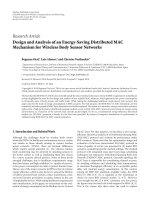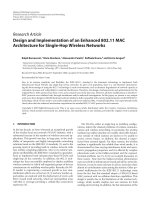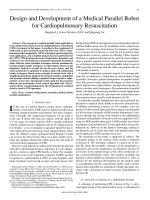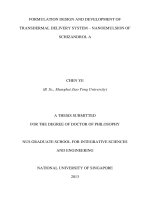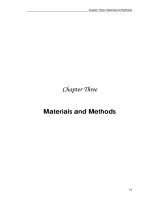Design and development of an on machine profile measurement system for an ELID grinding machine
Bạn đang xem bản rút gọn của tài liệu. Xem và tải ngay bản đầy đủ của tài liệu tại đây (3.23 MB, 133 trang )
DESIGN AND DEVELOPMENT OF AN ON-MACHINE
PROFILE MEASUREMENT SYSTEM FOR AN ELID
GRINDING MACHINE
Mohammad Sazedur Rahman
B.Sc in Mechanical Engineering
Bangladesh University of Engineering & Technology
A THESIS SUBMITTED
FOR THE DEGREE OF MASTER OF ENGINEERING
Department of Mechanical Engineering
National University of Singapore
2007
ACKNOWLEDGMENTS
The author would like to express his deepest and heartfelt thankfulness and
appreciation to his supervisor, Professor Dr. Mustafizur Rahman and former supervisor
Dr. Lim Han Seok, for their invaluable guidance, continuous support and encouragement
throughout the research work. Whenever any problems arose they were there to give
some of their valuable moments and helped to come out of that problem. Their comments
and advice during the research have contributed immensely towards the success of this
work. In addition, their patient guidance and suggestions have also helped the author in
learning more.
The author also would like to thank National University of Singapore (NUS) for
supporting his research by the research scholarship and to Workshop 2, Advanced
Manufacturing Lab (AML) and Micro Fabrication Lab for the state of the art facilities
and support without which the present work would not be possible. His heartfelt
appreciations will also go to Mitutoyo Association of Science and Technology, Japan for
their generous financial support towards the development of this on-machine
measurement device.
The author would also like to thank the following staffs for their sincere help,
guidance and advice: Mr. Neo Ken Soon, Mr. Lee Chiang Soon, Mr. Lim Soon Cheong,
Mr. Tan Choon Huat, and Mr. Chua Choon Tye. He also acknowledge helpful cooperation from NUS Spin-off company MiktroTool Pvt. Limited’s staff Mr. Atiqur
Rahman.
i
The author would again offer his appreciation for the support and encouragement
from his research colleagues and lab mates who have encouraged and helped him along
the way. His appreciation goes to Tanveer Saleh, Majharul Islam, Wang Zhigang, Altabul
Quddus, Sadiq M Alam, Masheed Ahmad, Indraneel Biswas and many more.
Last but not least his heartfelt thank to his family members who have always been
there to support him in all kinds of ways and prayed for his better performance.
ii
CONTENTS
Acknowledgement……………………………………………………………..i
Contents………………………………………………………………………..iii
Summary………………………………………………………………………ix
List of Tables…………………………………………………………………..xi
List of Figures…………………………………………………………………xii
CHAPTER 1:
INTRODUCTION
1.1 Significance of Research ……………………………………………..…….1
1.2 Scope of this study………………………………………………….……….5
1.3 Organization of the dissertation…………………………………….……….6
CHAPTER 2: LITERATURE REVIEW
2.1 Introduction………………………………………………………………....8
2.2 Historical background of ELID grinding process…………………………..9
2.3 Development ELID grinding……………………………………………....10
2.4 Essential components of the ELID ………………………………………..12
2.4.1 The ELID-grinding wheels……………………………………….12
2.4.2 The electrode……………………………………………………..13
2.4.3 Material for the ELID electrode………………………………….13
2.4.4 Electrode-Wheel Gap……………………………………………..14
2.4.5 Electrolyte………………………………………………………...14
2.4.6 Power sources……………………………………………………..15
iii
2.5 Mechanism of the ELID grinding…………………………………………15
2.6. Machine development for generating aspheric surface ………………….16
2.7 On-machine profile measurement ……………………………………..….18
2.7.1 3D shape Measurement …………………………………….…...18
2.7.2 Non Contact Probe ……………………………………………...18
2.7.3 Optical reference profilometer ……………………………….…20
2.7.4 Phase-shifting image digital holography ………………………..21
2. 7.5 Optical inverse scattering phase method …………………….…22
2.7.6 Multi-Iteration CMM …………………………………………....22
2.7.7 Compact high-accuracy CMM ……………………………….…22
2.7.8 Nano-CMM probe ……………………………………………....23
2.8. Error compensation ………………………………………………………23
2.8.1 Improvement of form accuracy ………………………………….25
2.8.2 Improvement of machining accuracy …………………………25
2.8.3 Error mapping …………………………………………………..26
2.9. Surface roughness ………………………………………………………..26
CHAPTER 3
DESIGN AND DEVELOPMENT
3.1 Introduction …………………………………………………………….28
3.2 Design and development of ELID grinding machine …………………..28
3.2.1 Design Consideration………………………………………….29
3.3 The new ELID machine…………………………………………………29
3.3.1 The Power Supply …………………………………………….31
3.3.2 Fabrication of the electrode-holder……………………………31
iv
3.3.2.1 Design Considerations…………………………………31
3.3.3 The Electrode-Holder……………………………………….……33
3.3.4 The Turntable……………………………………………….……33
3.4 Design and development of an on-machine profile measurement system…34
3.4.1 Design considerations ………………………………….………...35
3.4.2 Selection of Appropriate Probe………………………….………..35
3.4.3 LP2 probe head ………………………………………….……….36
3.4.4 Selection of Stylus ……………………………………….……….36
3.4.5 Design and development of the probe setup……………….……...37
3.4.6 Measurement Software ……………………………………….…..39
3.4.7 Working Principle of the Measurement System …………….……40
3.5 In Process Wheel Monitoring System ………………………………….…..42
3.5.1 Working principle of the system……………………………….….42
CHAPTER 4:
EXPERIMENT SETUPS
4.1 Introduction ………………………………………………………………45
4.2 Details of experimental setup …………………………………………….45
4.2.1 CNC ELID Grinding Machine …………………………………46
4.2.2 Workpiece material …………………………………………….47
4.2.3 Mounting of workpiece ………………………………………...47
4.2.4 Grinding wheels ………………………………………………..48
4.2.5 Electrolyte ………………………………………………………48
v
4.2.6 Pre-dressing ………………………………………………………..49
4.2.7 Wear measurement of the grinding wheel……………………….....49
4.3 Standard measuring equipments used …………………………………….….49
4.3.1 Mahr OMS-400 CMM Machine …………………………………...49
4.3.2 Mitutoyo FORMTRACER …………………………………….......50
4.3.3 Taylor Hobson Machine ……………………………………….......51
4.3.4 Keyence VHX digital Optical Microscope ………………………...53
4.3.5 Jeol JSM-5500 Scanning Electron Microscope ……………………53
4.4 Detail experimental procedures ……………………………………………...54
4.4.1 Generation of tool path ……………………………………………54
4.4.2 Experimental procedure ……………………………………………56
CHAPTER 5:
RESULTS AND DISCUSSION
5.1 Introduction …………………………………………………………………61
5.2 Repeatability and accuracy of the machine tool …………………………….61
5.3 Repeatability and accuracy of the OMM system …………………………...63
5.4 Wheel wear measurement …………………………………………………..65
5.5 Ground surface profile measurement by OMM system …………………….67
5.5.1 Profile measurement of Perspex workpiece ……………………….68
5.5.2 Profile measurement of BK7 Glass workpiece ……………………71
5.5.3 Analysis of different profile values measured …………………….72
5.6 Profile accuracy ……………………………………………………………...74
5.6.1 Profile accuracy of the Perspex workpiece ………………………..74
vi
5.6.2 Profile accuracy of the BK7 workpiece ……………………………..75
5.6.3 Effect of Software Compensation on Profile Accuracy ……………...76
5.7 Form accuracy ……………………………………………………………........77
5.7.1 Form Accuracy BK7 Glass piece ……………………………….........78
5.7.2 Form Accuracy of Perspex Workpiece ……………………………….79
5.7.3 Analysis of different form accuracy ………………………………….80
5.8 Measurement of surface roughness ……………………………………………..81
5.8.1 Surface roughness of Perspex …………………………………………81
5.8.2 Surface Roughness of BK 7 Workpiece ………………………………82
5.8.3 Analysis of Surface Roughness ……………………………………….84
5.8.3.1 Influence of grinding wheel speed ………………………….85
5.8.3.2 Influence of work rotation speed ……………………………85
5.8.3.3 Influence of feed rate ………………………………………..85
5.9 Study of ground surface integrity ……………………………………………….86
5.9.1 Analysis of Surface Integrity ………………………………………….91
CHAPTER 6: CONCLUSIONS AND RECOMMENDATIONS
6.1 Major Contributions………………………………………………………………93
6.1.1 Design and development of a CNC ELID grinding machine…..............93
6.1.2 Develop an on-machine measurement system for measuring ground surface
profile ………………………………………………………………………..94
6.1.3 Machining of aspheric surface on hard and brittle material with and without
software compensation……………………………………………………….94
vii
6.1.4 Report on improvement in dimensional accuracy of finished part ground
with software compensation …………………………………………………94
6.2 Recommendations for further improvement……………………………………...94
6.2.1 Possibility of improving the machine tool ……………………………..95
6.2.2 Possibility of improving the ELID process …………………………….95
6.2.3 Possibility of improving the turntable…………………………………..95
6.2.4 Improvement of form accuracy…………………………………………96
REFERENCE ……………………………………………………………………….97
LIST OF PUBLICATIONS……………………………………………………….103
APPENDIX
Appendix A
Detailed drawings of different devices
Appendix B
Component specification
viii
SUMMARY
Recent improvement of optoelectronic industry has put some stern challenge to the
people in the arena of manufacturing to generate aspheric surface on hard and brittle
material. Dimensional accuracy and surface quality is also needed to meet the
requirements of high end optical devices. When the world of manufacturing is so much
competitive to give the best product and most economical price it is really a challenge for
the lens manufacturers to ensure lower price with high precision.
Improvement of dimensional accuracy of the finished product is one of the prime
goals of this study. Shifting towards more sophisticated machine tool will definitely
improve the accuracy of the finished product. But not necessarily this is a wise decision
in every case. However it was found that in practical cases there are some quasi-static
systematic errors which reduce the dimensional accuracy of the finished product. Over
the years it has been proved that, software compensation is a very economical way of
controlling these errors and improving the dimensional accuracy of the finished product.
Electrolytic in Process Dressing (ELID) grinding has established itself as a very
efficient process for generating submicron level surface on hard and brittle materials
which is a basic requirement of an aspheric lens. In this study a fully functional 4 axis
CNC ELID grinding machine has been developed. To incorporate the machining of free
form surface one workpiece rotational axis was also attached to this system.
ix
On-machine measurement systems were developed in this study to measure ground
surface profile and diameter of the grinding wheel. A very efficient on-machine profile
measurement system has been developed based on Coordinate Measurement Machine
(CMM) principle to check the ground surface profile during machining. Wheel wear was
also measured at some regular interval to find out the latest wheel diameter possible. Tool
path in the NC program was updated with this change in wheel diameter.
Free form surfaces were generated on BK7 glass and Perspex with and without
compensating the tool path. Profile of the finished workpiece was measured in a
commercially standard CMM machine and significant improvement of dimensional
accuracy was reported.
Surface roughness was also measured using some standard roughness measuring
equipment available in the lab. Different roughness parameters obtained were analyzed.
In order to investigate the surface integrity the machined surface was observed under
SEM and optical microscope with very high magnification.
x
LIST OF TABLES
Table 3.1:
Specifications of the ELID Grinding Machine
30
Table 3.2:
Technical Specifications of the DC power supply
31
Table 4.1:
Specification of the Mitutoyo machine
51
Table 4.2:
Specification of the Taylor Hobson machine
52
Table 4.3:
Parameters of the experiment
58
Table 5.1:
Change in tool path with wheel diameter change
66
Table 5.2:
Coordinates measured by the OMM system
69
Table 5.3:
Comparison between different measuring methods
72
Table 5.4:
Table for different profile radius measured
77
Table 5.5:
Measurement condition
82
Table 5.6:
Measured value of Roughness
83
Table 5.7:
Different Roughness values Measured
84
xi
LIST OF FIGURES
Figure 2.1:
Self-sharpening effect of the conventional grinding wheel
11
Figure 2.2
Schematic illustration of the ELID system
12
Figure 2.3:
Metal bonded grinding wheel
13
Figure 2.4:
Principle of the ELID grinding process
16
Figure 3.1
(a): Schematic design of the ELID Machine
(b): Photograph of the developed system
30
Figure 3.2:
(a) CAD drawing (b) Real image of the Electrode-holder
32
Figure 3.3:
CAD drawing of the turn table
34
Figure 3.4:
picture of the turn table from (a) front and (b) rear side
34
Figure 3.5:
(a) CAD Drawing and (b) Photograph of the
on-machine profile measurement system
39
Figure 3.6:
GUI of the Measurement software
40
Figure 3.7:
Working Principles of the measurement system
41
Figure 3.8:
Flow chart to calculate wheel radius from
in-process wheel monitoring system
43
Figure 4.1:
ELID Grinding system developed
46
Figure 4.2:
workpiece used for grinding (a) BK7 glass (b) Perspex
47
Figure 4.3:
CAD drawing of workpiece mounted on the mounting plate
48
Figure 4.4:
Picture of the Mahr OMS-400 CMM Machine
50
Figure 4.5:
Picture of the Mitutoyo FORMTRACER CS-500
51
Figure 4.6:
Picture of the Taylor Hobson Talysurf Model 120
52
xii
Figure 4.7:
Picture of the Keyence VHX Microscope
53
Figure 4.8:
A Photograph of Jeol JSM-5500 Scanning Electron Macroscope
54
Figure 4.9:
Workpiece-wheel orientation during machining
56
Figure 4.10:
Schematic of the tool path
56
Figure 4.11:
Schematic illustration of the experimental setup
57
Figure 4.12:
Block diagram of the experimental process
59
Figure 5.1(a): Interferometer reading for X axis
62
Figure 5.1(b): Interferometer reading for Y axis
62
Figure 5.1(c): Interferometer reading for Z axis
63
Figure 5.2:
Repeatability and accuracy test of the measurement system
65
Figure 5.3:
Wheel profile Measurement
67
Figure 5.4:
Surface Generated using the measured coordinates
68
Figure 5.5:
Surface Generated by the points measured in the OMM system
72
Figure 5.6:
Profile accuracy of the Perspex workpiece measured in Mitutoyo
machine
Figure 5.7:
Profile accuracy of the BK7 Workpiece (With software compensation)
measured in Mitutoyo form tracer
Figure 5.8:
76
Form accuracy of the BK7 lens (with software compensation)
using Mitutoyo CS-500
Figure 5.10:
75
Profile accuracy of the BK7 workpiece (without software compensation)
measured in Mitutoyo form tracer
Figure 5.9:
74
78
Form accuracy of the BK7 lens (without software
compensation) using Mitutoyo CS-500
79
xiii
Figure 5.11:
Form accuracy of the Perspex lens using Mitutoyo CS-500
80
Figure 5.12:
Surface Roughness of the Perspex workpiece
82
Figure 5.13:
Surface Roughness of BK7 glass measured in Taylor Hobson
machine
83
Figure 5.14:
Surface roughness measured in Mitutoyo CS-500 form tracer
84
Figure 5.15:
Finished (a) Perspex and (b) Glass sample after grinding
86
Figure 5.16:
(a) 3D (b) 2D view of the Perspex surface under Keyence
microscope
Figure 5.17:
2D image of the Ground glass Surface observed under Keyence
microscope
Figure 5.18:
88
3D image of the Ground glass Surface observed under Keyence
microscope
Figure 5.19:
87
88
Surface topography of the glass piece observed under Keyence
Microscope
89
Figure 5.20 (a): SEM images of the ground surface after 2500 times’
magnifications
89
Figure 5.20(b): SEM images of the ground surface after 1500 times’
magnifications
Figure 5.21:
90
Ground glass (without software compensation) under Keyence
microscope
90
xiv
Chapter 1: Introduction
CHAPTER ONE
INTRODUCTION
1.1 SIGNIFICANCE OF RESEARCH
The hasty market progress in optoelectronics industry has led to increasing
demands for machining aspheric and other free-form surfaces on hard and brittle
materials with very high profile accuracy which in turn puts stern requirements on the
manufacturing equipment.
Optical elements get expensive in proportionate with its precision and application.
Even in case of consumer products it is expensive enough if we leave the case of very
high quality aspherical mirrors used in astronomical observatory. In case of consumer
products the biggest challenge the manufacturers are facing now a days is to present
highly accurate product at a very competitive price. The aspheric surfaces used in the
optical systems can control the aberrations and reduce the number of elements without
diminishing image quality and thereby results lighter optical systems. Even asymmetrical
and eccentric surfaces can eliminate obscurations to improve the image quality [Derk
Visser et al, 1985; C.S. Han et al, 2004]. So application of aspheric lenses in optical
systems makes it possible to improve system performance without increasing the price.
As a result optical components of large sized aspheric surface have gained significant
importance and indispensability.
1
Chapter 1: Introduction
Glasses exhibit desirable optical properties needed for advanced optical instruments
[C.S. Han et al.]. High hardness and brittleness make it very difficult to machine glasses
frees from subsurface damages using conventional turning or grinding machines. As a
result, proficient and cost-effective manufacturing techniques for generating high quality
aspheric surfaces on glass with very accurate profile are still a challenge faced by
manufacturers.
According to market expectations on required accuracy of optics and the
international optics standard (ISO 10110), an overall machining accuracy better than 200
nm is expected. Currently available commercial machines cannot fully meet these
requirements [Qian et al]. Aspheric components needed to be with higher form accuracy
than other traditional devices especially when the wavelength used in modern optics are
progressively smaller [Yousef A. et al.]. Where as non-rotational symmetry causes
manufacture of such optical elements made of brittle materials considerably more
difficulty, so these elements are more expensive and rare. Ductile mode machining of
hard and brittle materials like glass and ceramics to optical quality is now considered as
an emerging technology.
Single point diamond turning with a fast tool servo is a more conventional way to
engender high quality freeform surfaces, but the number of materials machinable with
this method is limited. In most of the cases free form surfaces are generated by grinding
and then followed by lapping or polishing to achieve the surface finish in sub-micron
level. Grinding and polishing aim to improve the forming and dimensional accuracy as
2
Chapter 1: Introduction
well as the surface finishing. Both processes play an important role as they are at the end
of the manufacturing chain. So researchers have tried to improve the grinding process
over the years.
Wet grinding, owing to its ability to produce superb form accuracy and surface
integrity on hard and brittle materials, remains as one of the most important and feasible
machining technologies to date [Shinya Moritaa et al.]. Usually a rough aspheric form is
generated by grinding or milling followed by very time consuming lapping and polishing
process to get rid of damaged layers or tool marks which were created my rough cutting
and provide a high quality surface. But it is impossible for this polishing process to
improve the form accuracy and it can even make it worse. So over the years researchers
have tried for innovative ideas to make this grinding process more efficient in grinding
aspheric surfaces with higher form accuracy.
Loading, dulling and shedding on a grinding wheel frequently occur under
inappropriate grinding conditions which causes a blur machined surface. The working
surface of a grinding wheel is dressed at a certain interval to avoid the burning.
Electrolytic in process dressing(ELID) grinding introduced by Murata et al in the year of
1985 is a very efficient process of achieving mirror surface finish on very hard and brittle
material like glass, wafer etc. ELID grinding method was further improved by Ohmori
and Nakagawa in 1990 and they succeeded in establishing this process in any
conventional grinding machine with minimal amount of modifications [H. S Lim et al.].
3
Chapter 1: Introduction
So by replacing the normal grinding with the ELID it is possible to reduce the lapping
and polishing time without compromising with the surface quality.
One of the very significant factors for the better performance of optical elements
is the form accuracy of the lenses it uses. In practice, the machined part dimension
deviates from the desired value owing to many quasi-static systematic errors: geometric
error of machine tool, thermally induced distortions of machine tool elements, error
arising from the static deflection of machine- fixture-workpiece-tool system under the
cutting force and other errors such as those arising from clamping force, tool wear etc.
The machining accuracy is commonly determined by the kinematics accuracy of NC
machine tool and a big portion of machines used are with low kinematic accuracy, which
prevents many manufacturing enterprises from producing high quality products. Software
based error compensation is a method of anticipating the combined effect of all these
above factors on workpiece accuracy and suitably modifying the NC program. Owing to
its reliance on modification of software rather than hardware, it is considered to be a
direct and very economical method of achieving higher machining accuracy without
having resort to higher accurate machine. Although a considerable research work have
been reported to improve the kinematic accuracy of the machine tool which are too
sophisticated to implement, there are few programs that focus on modifying the NC code
to compensate the movement error [Saroti et al.].
Since it is not possible to get the desired form in single shot, the ground surface
profile is needed to be measured to compensate in the NC program. The main problem in
4
Chapter 1: Introduction
measuring the surface profile is that, if it is removed from the machine the accuracy will
be gone. So the measurement needed to be done without removing the workpiece form
the machine which is called on-machine measurement. So in this study one of the
primary goals was to develop an on machine measurement system for measuring the
ground surface profile.
Grinding wheel diameter is one of the key factors in determining the tool path in the NC
program. This tool path needed to be updated from time to time as wheel diameter
changes due to wear. So in this study wheel diameter was also measured during the
process to change the tool path in the NC program.
1.2 SCOPE OF THIS STUDY
Scope of this study can be briefly summarized as follows:
•
Design and develop a fully functional 4 axis CNC ELID grinding machine for
performing ELID grinding process on hard and brittle material.
•
Design and develop a turn table for using it as an attachment in providing rotary
motion to the workpiece.
•
Design and develop an on-machine measurement system for measuring the free
form surfaces machined in the machine.
•
Measure the grinding wheel diameter regularly to compensate wheel wear in the
tool path of the NC program.
•
Fabricate aspheric surface on hard and brittle material with regular update of tool
path in the NC program.
5
Chapter 1: Introduction
•
Study on different factors responsible for the dimensional accuracy of the free
form surface machined by ELID grinding process.
1.3 ORGANIZATION OF THE DISSERTATION
There are six chapters in this dissertation. In this chapter background of this study
was discussed. Also scope and research objectives were summarized.
Chapter 2 is divided into 9 sections giving a comprehensive review of the
literature. The ELID process is discussed in details. Research works done on profile
measurement and error compensation are also reported.
Chapter 3 describes the design and development of the experimental setups.
Factors considered during design and different components used are also mentioned in
details in this chapter.
Chapter 4 contains experimental setups in details. It also explains the procedures
of the experiments. There is a brief description of the different standard instruments used
for measurement in this study.
Chapter 5 presents different informations gathered by the experiments. It also
analyzed the results obtained.
6
Chapter 1: Introduction
Chapter 6 concludes the thesis with a summary of contribution. Further
recommendations are also provided to move forward with this study in future.
7
Chapter 2: Literature Review
CHAPTER TWO
LITERATURE REVIEW
“When you can measure what you are speaking about and express it in numbers you
know something about it; but when you cannot measure it you cannot express it in
numbers, your knowledge is meager and of unsatisfactory kind.” Lord Kelvin
2.1 INTRODUCTION
Measurements are done to gain reliable quantified information about our real
world. Although everybody has accepted the importance of metrology in manufacturing
still it is often regarded as a cost factor and very seldom as a value adding activity. So in
many cases one of the most important aims of production engineers is to reduce
metrology costs to an absolute minimum. In this study a very economical and efficient
on-machine profile measurement system has been developed to measure the profile of the
ground surface generated by ELID grinding process.
ELID grinding has great potentialities in the field of manufacturing high precision
optical lenses due to its ability to produce high quality surface on hard and brittle
materials. Dimensional accuracy is one of the most important factors for a lens to be
qualified for being used in optical industry. In this chapter after describing the basic
mechanism of ELID grinding some works dedicated to improve the dimensional accuracy
of a finished product will be reviewed. Lastly, different works done on the development
8
Chapter 2: Literature Review
of a very economical way to improve the dimensional accuracy free form surfaces
machined by ELID grinding was studied.
2.2 HISTORICAL BACKGROUND OF ELID GRINDING PROCESS
The ELID technique was originated from Japan, and most of the works reviewed
were reported from Material Fabrication Lab, RIKEN, Japan. Murata et al. [Murata et al.,
1985] introduced ELID in 1985 for the application of abrasive cut-off of ceramic. The
structural ceramics are highly difficult to grind due to its hard and brittle nature.
Normally for grinding harder materials, the softer grade grinding wheels have been used.
But, the softer grinding wheels have the problem of large diameter decrease due to wheel
wear. Therefore, stronger bond with harder abrasives have been selected for grinding
hard and brittle materials. When the grits are worn out, a new layer in the outer surface is
electrolyzed and necessary bonding is removed from the grinding wheel surface in order
to realize grit protrusion. The results of the experiments performed with different grades
of grinding wheel showed that the grinding force was reduced to a significant amount
when the in-process dressing was done. Even though the surface finish is not a major
criterion in abrasive cut-off, the surface roughness also improved due to the application
of the ELID. The experiments show that ELID is an effective process of increasing
surface quality even though it has some problems like rust formation due to electrolyte
application [Murata et al., 1985].
Ohmori et al. [Ohmori and Nakagawa, 1990] further improved ELID suitable for
super-abrasive grinding wheels. Different types of grinding wheels have been used along
with ELID grinding [Ohmori et al., 1999, 2000]. The grinding wheels used in ELID are
broadly classified into the following:
9
Chapter 2: Literature Review
♦ Metal-bonded diamond grinding wheels and
♦ Metal-resin-bonded diamond grinding wheels
The grades of the grinding wheels are ranging from #325 to #300,000, which have an
average grit size from 38 μm to 5 nm. The basic ELID system consists of a metal bonded
diamond grinding wheel, an electrode, a power supply and an electrolyte [Ohmori and
Nakagawa, 1990].
2.3 DEVELOPMENT ELID GRINDING
Periodic dressing of grinding wheels is cumbersome and also produces inaccuracy
during the process. The main requirement for a grinding wheel is its ability to replenish
the topography and promotes an uninterrupted grinding (or with minimum interruptions).
When grinding is performed with conventional grinding wheels (other than metalbonded), the worn out grits are removed automatically by the grinding force and the grits
beneath come into contact with the workpiece. This is known as the ‘self-sharpening’
effect as shown in Figure 2.1. This effect makes the in-process dressing necessary and
grinding becomes continuous. The conventional wheels are also prepared with certain
porosity in order to provide space for chip and coolant [Malkin, 1987; Shaw, 1996].
However, the wheels have the properties described above are suitable for machining
metals or materials with less hardness and they are not recommended for grinding harder
material because of intense diminution of wheel diameter. Therefore, wheels with high
bonding strength are quite suitable in order to withstand higher grinding forces generated
during grinding.
10


